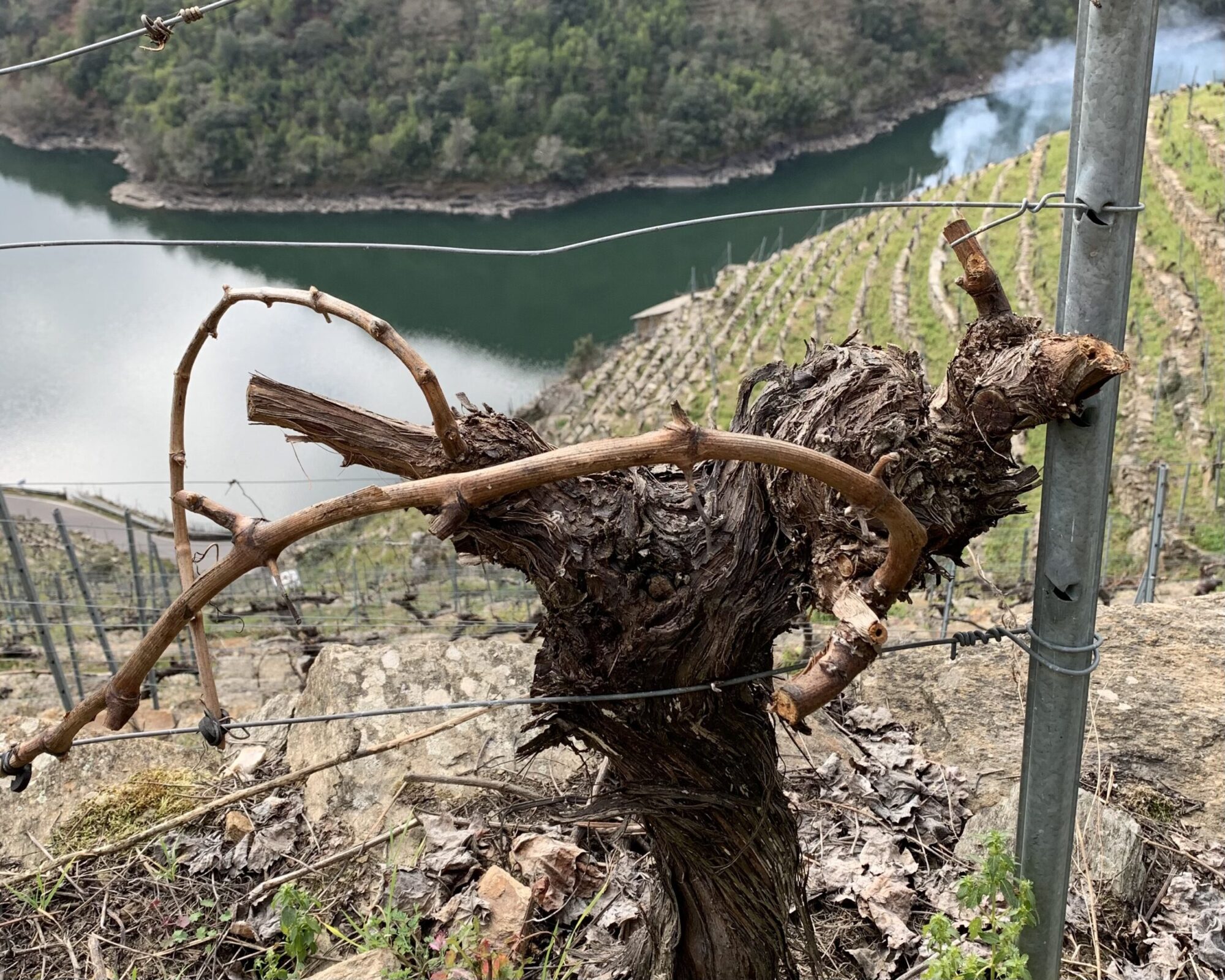It’s winter in the Ribeira Sacra. Wine slumbers peacefully inside tanks and barrels, and workers criss-cross the stony terraces lining the Miño and Sil, pruning vines in preparation for the warm weather that’s just around the corner. For some growers, winter is also the season of signing contracts to negotiate the sale of grapes during the harvest season. The lucky ones have already heard from the wineries they usually supply with grapes that this year will be business as usual. For others, there’s no sign of the agreements they used to sign at this point.
Though it’s not a full-blown crisis yet, a storm is building on the horizon. The average age of Ribeira Sacra’s growers hovers around 65, and the cost of eking out a living in the region’s extreme terrain poses serious difficulties for the future. According to a study by the Interprofesional del Vino de España, the minimum production cost per kilo of grapes in Ribeira Sacra is €1.20, including labor and treatments. Most of the time, that number is also the price wineries pay for a kilo for the highest-quality mencía. Rather than growing grapes in their own vineyards, wineries here have always preferred to buy grapes from growers they kept on yearly contracts. But the global drop in red wine sales that’s being felt from small regions like Ribeira Sacra to juggernauts like Bordeaux is calling the usual model into question.
Ribeira Sacra's Growing Problems
Last year, large wineries like Rectoral de Amandi, Dominio do Bibei, or Regina Viarum brought in more or less the same amount of grapes as previous harvests, but others trimmed down their list of suppliers. Rectoral de Amandi can process almost three million kilos of grapes—about half the production of the entire DO—and produces about two million bottles. In contrast, the next-largest wineries can process about 300,000 kilos per harvest.
All this production is good for growers looking to sell their grapes, but doesn’t help Ribeira Sacra’s image on the world stage: Rectoral de Amandi’s flagship wine sells for less than €8 in Spanish grocery stores. In a region where only a fifth of wineries follow the récoltant manipulant model, farming small plots and producing less than 5,000 bottles, decisions made by the biggest players can reverberate across the entire appellation and affect a huge proportion of its growers. For now, Rectoral de Amandi’s parent group has decided to continue buying grapes from the most veteran winegrowers that appear in its supplier portfolio.
In the 2023 harvest, most wineries made the most of their purchasing power to stem a loss of income for growers and prevent economic losses from translating into vineyard abandonment. Despite their efforts, there were vineyards that went unharvested. Other regions, most notably Rioja, resorted to distilling excess wine into alcohol for industrial use—an extreme measure that requires approval from the European Union. Elsewhere in Spain, appellations like Penedés, Terra Alta, Tarragona, and Extremadura also distilled excess wine in 2023. In Ribeira Sacra, the regulatory council came close to implementing a crisis distillation, but backed down at the last minute.
Faced with dwindling profitability, some see government subsidies as a way out of the hole. The Galician Nationalist Bloc (BNG) are willing to use their seat in the European Parliament to demand that Ribeira Sacra benefits from some specific line of aid addressing “the peculiarities of its viticulture and its high production costs.”
These types of subsidies are common in areas that also practice “heroic viticulture,” characterized by growing vines on terraces or steep slopes. In Spain, growers in the Canary Islands have long received similar subsidies, and last year the Canary Islands government approved a grant allocating up to €2,500 per hectare for vineyards with agricultural insurance. If the BNG is successful, European funds could provide where the Galician Popular Party fell short: in 2017, when Ribeira Sacra’s candidacy as a World Heritage Site was being drawn up, the D.O. asked the Galician government for yearly subsidies of €1,200 per hectare for vineyards that fall within the scope of Ribeira Sacra’s “cultural landscape.” The annual cost would have been about €1.2 million euros, but like the World Heritage candidacy, the proposal died on the vine.
Next Steps
There’s no easy solution to the global red wine glut, and only time will tell if markets will recover and wineries will be able to sell the excess wine from their stocks. But there are steps Ribeira Sacra can take. The path forward needs to revolve around positioning the region’s best wines at the forefront of its marketing campaigns, instead of bulk wines that sell for €5 in grocery chains. In its export missions, the D.O. needs to put its proverbial best foot forward and lead with producers like Algueira or Guímaro, who regularly pop up on trendy wine lists, rather than positioning cheaper wine as a representative face of Ribeira Sacra.
This “vino de chateo” as it’s called in Galicia may work at home—Northwest Spain makes up a whopping 94 percent of the region’s market—but something needs to change if these wines are going to compete on a global scale. If Ribeira Sacra is going to survive and thrive, both the D.O. and wineries need to work hard to make consumers understand why production costs are so high, and why the region is one of Spain’s most remarkable. As winter moves into spring and sap starts flowing in the vines, hopefully ideas and innovation will start flowing too.
